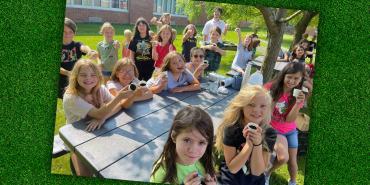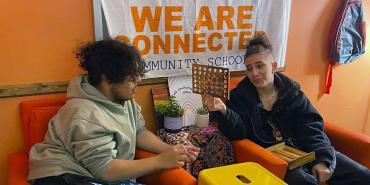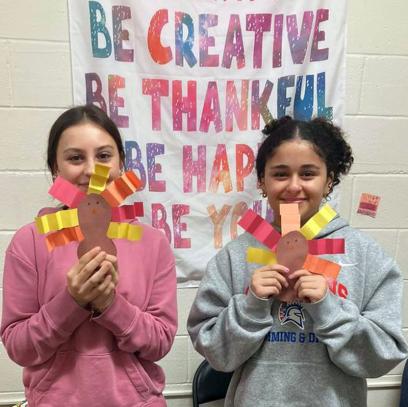When people talk about community schools, they might have one in mind—one public school where students feel held and safe, where their basic needs are met so they are prepared to learn and where, if they are experiencing life challenges—from a small hiccup like getting to school on time to life-altering trauma—there are people at school who can help.
AFT members in central New York have not one but scores of schools like this.
This year, the Rome Teachers Association celebrated the fifth anniversary of a community schools network that began as one school in Rome and grew into 53 schools in 15 districts and eight counties. It’s been a busy five years.
“It took a lot of work from a lot of people” to come this far, says Melissa Roys, co-director of Connected Community Schools, which oversees operations across the region. “It is the epitome of collaboration. I think that’s why we’ve been successful.”
The basics
Community schools are well-known for bringing people and resources together and turning schools into hubs of support. Many children come to school unprepared to learn because their families are struggling with challenges like food insecurity or lack of appropriate clothing, medical care and hygiene. They might be missing resources like Wi-Fi, reliable transportation and child care, or experiencing mental health challenges or violence in their neighborhoods or homes. They might be distracted because of a move, or changing family dynamics: an older sibling moves out, a parent leaves, a grandmother dies.
Community schools step in to help: They offer food pantries and clothing closets, backpacks full of school supplies and hygiene products, on-site visits with dentists and eye doctors, and school social workers, counselors and psychologists to help families cope with stressful situations. More important, community schools create relationships among students, teachers, school staff, families and community members. School becomes a central place where people gravitate for whatever they might need: night classes, access to computers, social events, sports and games—connection.
Once these basics are in place, children are more available for learning. That’s why community schools are so effective—and why they are a leading part of the AFT’s Real Solutions for Kids and Communities campaign, along with an emphasis on literacy, career and technical education, mental health and well-being, and investments in schools.
In the beginning
The explosion of community schools in and around Rome was sparked by two AFT members: Rob Wood, a high school science teacher and then-president of the Rome Teachers Association, and Joe Eurto, a middle school English teacher and RTA’s secretary at the time. The two colleagues attended the AFT’s 2015 Center for School Improvement Leadership Institute in New York City, where organizers introduced the idea of community schools.
Wood and Eurto were so intrigued they spent the four-hour train ride home talking about whether this could help their district. “Just thinking about the possibility, it made so much sense,” says Eurto.
Their town had gone through hard times: Manufacturing jobs, the mainstay of the community, had dried up. A busy air force base had also shut down, taking 10,000 residents with it. Families left behind were struggling, and so were their kids.
“The factories were gone, homelessness was on the rise, and kids had needs that weren’t being met,” says Wood. The school board and the union had been squabbling over testing, and both parties agreed: Student academic performance was troublingly low. But peeling away the blame and frustration, they began to see the problem went deeper than test scores.
That’s when Eurto and Wood learned about community schools. Eurto brought them up at a school board meeting: “I said I have a solution to our problem,” he recalls. He left board members with a packet of information; later they agreed to be part of an exploratory committee, and the rest is history.
A union endeavor
From the beginning, the union drove the project. New York State United Teachers backed the Rome educators, and the AFT awarded them an innovation grant to get the schools off the ground. But the intentional inclusion of community members who guided the work was the formula for success, says Wood. The mayor, NAACP leadership, faith leaders, the school district and the superintendent were all supportive; later local businesses came on board. Wood paraphrases what he calls “the Weingarten formula,” from AFT President Randi Weingarten, to explain the impact of this collaboration: “When you have the union working with people in a community on things that matter, that’s the formula for success.”
The exploratory committee visited other community schools across the country, noting what worked and what did not. They attended the AFT’s TEACH conferences and heard about the Real Solutions campaign, and how elements like mental health and literacy can be woven into the fabric of a school. They attended a second Center for School Improvement Leadership Institute, this time with 20 people—including parents, teachers, board of education members and administrators. “We did it collaboratively,” says Wood.
Eventually the group established a 501(c)(3), centralizing efforts that today include 80 employees—including site coordinators—as well as 100 community partners and a system called LiNK to connect students and families to the supports they need in what is now known as Connected Community Schools.
How it works today
The schools in and around Rome are a boon to the community—including educators who worry about their students. “Historically, we have had to scramble to make sure we put families in touch with the right person,” says RTA President Christina Steurrys, a high school science teacher. “Now you can make a simple referral, and there’s an array of services that can be accessed by the family. You don’t have to be up at night worrying” about how you are going to get help for a student who’s struggling with mental health or where a student who’s homeless will be sleeping that night, she says.
Instead of buying extra snacks and notebooks, teachers can send their students to the “hub,” where kids can pick up whatever they need and have a chat with the site coordinator if they have something on their minds. It’s “a huge emotional and psychological load that is lifted,” says Steurrys, and it allows teachers to focus more on instruction.
Teachers, parents, students and school staff have spread the word that this system really works. As the network began feeding and clothing families, hosting family engagement nights, and inviting community members like police officers and librarians into the classrooms, everyone could see the positive impact, says Roys.
One especially gratifying element is the “hub.” These in-school centers have become a magnet for students who just want a safe place to hang out. “Anyone can forget a notebook, forget a jacket, have mental health struggles,” says Roys, who has seen students encourage friends to join the “hub club” and pop in as needed—no stigma attached. She remembers one student who rarely attended school and almost didn’t graduate; he got lured into the “funky, colorful” space at the hub and ended up taking home groceries and clothing. More important, he developed a relationship with the on-site coordinator and felt as though he belonged. “We gave him a reason to come to school,” says Roys. “Whether it gets a student to school or it enhances their desire to be in school, we see it every day,” agrees Danielle Martin, CCS co-director.
When CCS hosted students returning to school to get their GEDs, Roys asked them why they hadn’t graduated initially. “Not one of those kids had anything to say about academics,” she says. Instead, they listed things like lack of transportation to school, domestic violence issues, moving and homelessness. “If we want kids to graduate, we have to support kids with what they need.”
[Virginia Myers]



